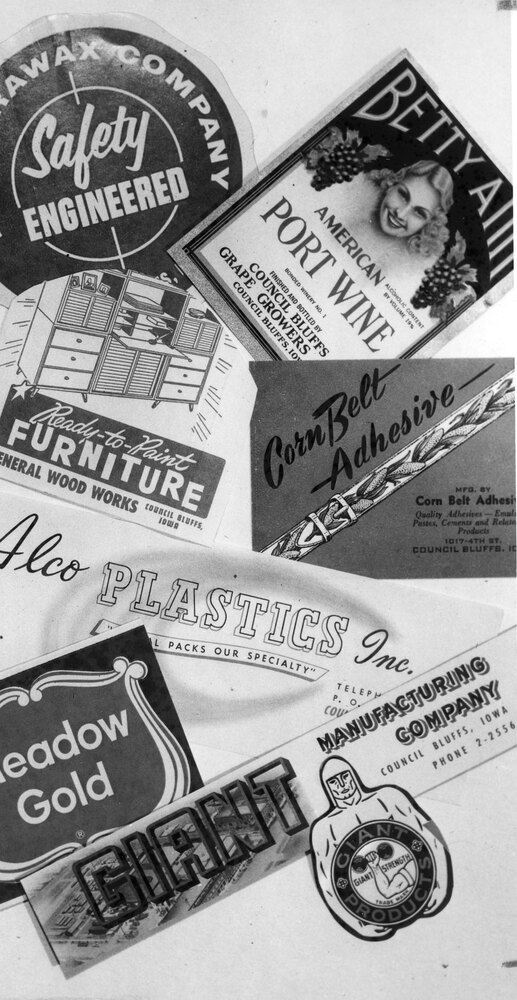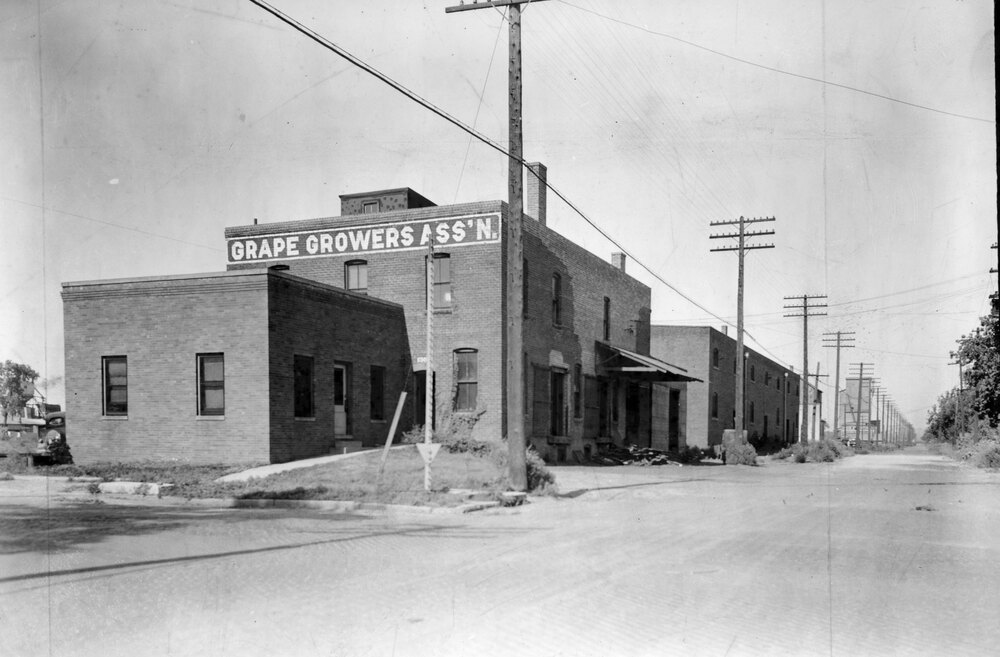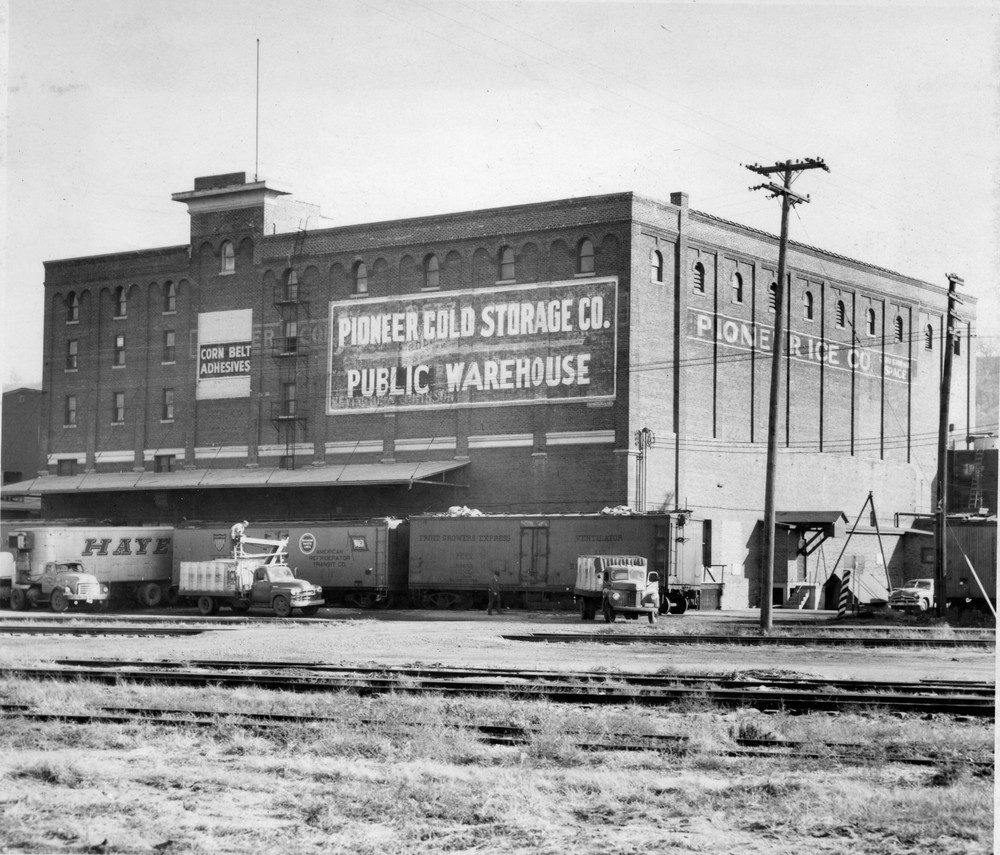
This is part two of a series focused on various company logos found in the August 21, 1958 issue of the Daily Nonpareil. A brief history of each business is included. The text from the original article read:
"Quiz a man about his home town, and he will surprise you with how little he knows-even of its most important assets. To any community a basic asset is its industry-the plants which provide paychecks for many of its citizens. And its products going out across the nation and the world are a city's most important ambassadors. Why do you know about Council Bluffs industry? The 37 insignia on this page represent a big share of the variety of products which might bear the label: 'Made in Council Bluffs.' How many do you recognize?"

issue of the Daily Nonpareil.
The Parawax Company started as the Wilson Chemical Company in 1912. Founded by S. P. Wilson and W. E. Wilson, it was located at 1216 and 1218 South 6th Street. The company produced and sold "cleaning and disinfecting compounds" according to the December 5, 1912 Daily Nonpareil issue. In 1917, the business moved to 700 South Main Street and in 1919, purchased the building from the Warehouse Construction Company. Wilson Chemical Co. later sold the building to Ford Transfer and Storage Company in 1922. By 1924, Wilson Chemical Co. no longer existed and The Parawax Company could be found in the city directory at 239 Merriam Block. It appears the new company still produced and sold cleaning products. In 1928, the company moved to 1200 3rd Avenue. Around this time, S. P. Wilson ran into some tax troubles and left the business. The Parawax Company was reorganized in 1930 with O. L. Young as the president and M. C. Warren as the vice president. Over the years the company developed and sold new products including "epoxy coatings and sealants, industrial cleaning and maintenance materials and accessory machines." The company was sold to James R. Erixon from Omaha in 1981. The company operated until around 1985 when it was no longer listed in the Council Bluffs city directories.
As the Mormons arrived in the area in the 1840s, they brought with them Concord grapes which they planted in the Loess Hills. Once the Mormons migrated westward, farmers then began utilizing the grapes as a crop. The Council Bluffs Grape Growers Association was formed in 1893 as a “co-operative marketing organization” that attempted “to secure the best prices for its members’ products.” Located at 900-904 South 7th Street in Council Bluffs, the association was managed by George W. Allingham. It was made up of farmers in Pottawattamie, Harrison, and Mills counties. There were hundreds of acres of grapes that ran from Mondamin to Hamburg near the Missouri River and 200 members in the Grape Growers Association at its peak. In 1929, the vineyards produced over 4 million pounds of grapes. The association operated as a “selling agency” for the fresh grapes until 1931 when it started making grape juice. In 1934, it started making wine. By this point, the association was managed by Harry Martin. It produced several varieties over the years including Old Council, Betty Ann, Prairie Queen, Jobbers’ and Vineyard Hills. In 1940, a new processing plant was completed at 700 9th Avenue, across the street from the original building. A number of reasons led to the decline of grape production in the area including “swarms of bees, small birds that sucked the sweet juices out of the grapes, the retirement of many of the steadfast grape growers in Pottawattamie County,” cold snaps, and the effect of a herbicide called 2-4D that adversely affected the grapes. Windy conditions would blow the herbicide into the vineyards and this would cause the grapes to ripen later in the year. This made them more susceptible to early frosts and would generally result in lower sugar content, affecting the quality of the grapes. Although the Iowa Legislature banned the “use of the more volatile types of 2-4D,” it was too late to help the grape growers. The Grape Growers Association closed in 1972.

General Woods Works was founded in 1917 in Omaha and in 1939, it moved to 105 South 31st Street in Council Bluffs. Co-owned by Morris Fox and Manny Goldberg, the company manufactured “unfinished furniture and institutional and store fixtures” including tables, cupboards, book cases, chests of drawers, and kitchen furniture. Products were left unfinished because it allowed clients to customize and paint the furniture. Their products could be found in schools and restaurants around the Midwest. At this time, the company did not engage in direct retail selling, instead distributing their products through wholesale merchants. A fire at General Wood Works on November 3, 1969 closed the plant down for a week or so. Although they rebuilt the business, the owners started looking for a larger building to operate out of. A 75,000 square foot building was constructed at 1101 South 20th Street in 1972. In 1971, General Wood Works was reportedly the first in Council Bluffs to introduce a four day work week for its employees. The company changed its business model in the early 1980s and opened an outlet warehouse so customers could purchase directly from General Wood Works. Around 1985, General Wood Works was transferred to an investment company called J. Lloyd Investments, Inc. In 1986, the company was sold to a Nebraska corporation called Kanesville Furniture. The business filed for bankruptcy and closed its doors in 1989.
Corn Belt Adhesives was formed in 1947 with O. R. Trubell as “president and production manager” and G. F. Rhodes as the “vice president and sales manager.” The company was located at 1017 4th Street on the second floor of the Pioneer Cold Storage Company building. A Daily Nonpareil article from July 10, 1955 includes a description of their production process. “The principal ingredient…is corn dextrine (sic). Dextrine (sic) is made by roasting starch” and the length of time for the roasting process determines how strong the glue product is. They also produced liquid glue and powdered glue. Liquid glue was used in the food packaging industry, particularly for “sealing flaps of packages and cardboard cases and cartons.” The powdered glue was used for wood. “These are used in cabinet making, laminating and setting for formica table tops.” The company also developed liquid synthetic resin that was supposed to be stronger and more resistant to deterioration. Their products were mostly sold in the Midwest. The company was bought by Reliance Battery Products Company in April of 1949 and Jack McMains became the assistant general manager. In December of 1957, Corn Belt Adhesives was then acquired by the H. B. Fuller Company, one of the largest manufacturers of adhesives to this day. The manufacturing plant in Council Bluffs was closed in early 1959 and at that time, had only three employees.

Alco Plastics, Inc. was founded on February 1, 1954 by Allan and Lucille Hoffman. Allan worked for Howard Plastics, Inc. prior to starting Alco Plastics. The business was located at 722 Indian Creek Top (also called Indian Creek Conduit and Creek Top Street). The company produced large “plastic carton and barrel liners” for industrial chemical applications. It also made plastic film for “packaging poultry and meat.” In 1956, the company was transferred to Lucille Hoffman, Allan’s ex-wife and it continued to operate until 1960.
A. & S. Dairy company was started in 1920 by William Alleman and Art Shea. The company was located at 205 South Main Street. It was purchased in 1928 by Beatrice Creamery Company and was then moved to 1607 West Broadway. This is when the name changed to A. & S. Meadow Gold. The company produced milk, butter, cottage cheese, buttermilk, and cocoa malt. Products were originally delivered to residents and businesses by horse-drawn carts before transitioning to company-owned trucks. In the early 1930s, the company was reportedly the first in the country to cap cream and milk bottles with an aluminum seal. The Meadow Gold plant was upgraded in 1959 with a $50,000 modernization project that brought the latest milk processing equipment to the facility and doubled its production capacity. The Meadow Gold plant stopped producing products around 1970 since “processing became more centralized” and the location became a distribution center. In 1985, the company halted home delivery of products because of “economic conditions and the high cost of operation.” The plant operated in this capacity until it was torn down in early 1990 to make way for the McDonald’s restaurant on 16th Street and West Broadway.
The Giant Manufacturing Company was started in 1905 in Harlan, IA by former Council Bluffs mayor George Jackson Harding. He recognized a need for a device that would allow “wires and pipes to be laid underground without having to first dig a trench” called a pipe pusher. This device allowed companies to save money on labor costs. “The business was a success, attracting contracts from Western Union and the American Telephone and Telegraph Company (AT&T) as well as a number of municipal water and gas utilities.” By 1910, the company had moved to Council Bluffs and was briefly located at 234 South Main Street before moving to a larger facility at 2100 South Avenue. Giant Manufacturing fabricated a variety of products over the years including truck frames, benches, flagpoles, basketball hoops, track and field hurdles, bleachers, ladders, diving boards and towers, air conditioners, flood lights for arenas and athletic fields, and playground equipment. In 1943, Giant Manufacturing was tasked with producing towers for the signal corps for the war effort. According to the July 13, 1943 issue of the Daily Nonpareil, “the size of the contract makes it necessary to expand existing facilities.” The company moved to 1126 South 6th Street. Giant also made cartridge storage cases for the war effort. These were “13-pound, water-tight metal containers that carry the propelling charge for the army’s big 155 mm howitzers.” These items were labeled “critical-urgent” by the army and Giant expanded its workforce significantly and opened a second production facility in Omaha at 812 Douglas Street. One third of their employees were women by 1944 in order to meet the demand. Giant Manufacturing is best known for its playground equipment. It started producing slides, merry-go-rounds, swings, etc. in 1919 and by 1929 they were “regarded by the industry as the largest manufacturer of playground equipment in the world.” The construction of the South Side Viaduct (South Expressway) in 1972 required the company to relocate to 3211 Nebraska Avenue. In 1975, Giant Manufacturing was purchased by Omaha investors. The company filed for bankruptcy in 1977 and was then sold to Ronald Norman in 1978. At this point in time, the company needed to downsize and moved to 2802 Avenue B. It continued for a couple of years until it was closed in 1984.
Click HERE for more information on Council Bluffs History.
Sources:
Various Daily Nonpareil articles
Various Omaha World Herald articles
Historical Society of Pottawattamie County newsletter (Apr/May 2014)